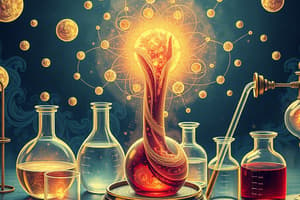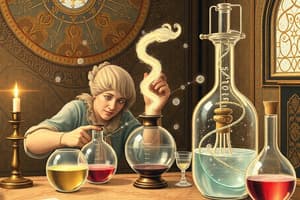Podcast
Questions and Answers
Which symbols represent different isotopes of the same element?
Which symbols represent different isotopes of the same element?
- Carbon-14 and N-14 (correct)
- O-18
- Rn-222 and Ra-222
- I-131 and I-131
Which table most accurately describes subatomic particles?
Which table most accurately describes subatomic particles?
- Contributes significant mass: Protons; Charge: Electrons
- Contributes significant mass: Protons; Charge: Protons
- Contributes significant mass: Electrons; Charge: Neutrons
- Contributes significant mass: Neutrons; Charge: Protons (correct)
Which of the following has the greatest mass (in grams)?
Which of the following has the greatest mass (in grams)?
- One mole of uranium (U) atoms (correct)
- One mole of silver (Ag) atoms
- One mole of lithium (Li) atoms
- All elements have the same mass since they all contain one mole of atoms
Use the periodic table to determine which mass spectrum most likely represents antimony (Sb).
Use the periodic table to determine which mass spectrum most likely represents antimony (Sb).
Which of the waves shown above represents the photon that has more energy than the other?
Which of the waves shown above represents the photon that has more energy than the other?
The valence shell is made up of which subshell types in a single energy level?
The valence shell is made up of which subshell types in a single energy level?
Which group number does the atom in the diagram belong to?
Which group number does the atom in the diagram belong to?
Which of the following has the same number of valence electrons as the atom in the diagram?
Which of the following has the same number of valence electrons as the atom in the diagram?
How many moles of potassium are contained in 9.02 × 10^23 atoms?
How many moles of potassium are contained in 9.02 × 10^23 atoms?
A student conducts a flame test on an unknown chloride salt, and a red photon of light is emitted. What does this indicate?
A student conducts a flame test on an unknown chloride salt, and a red photon of light is emitted. What does this indicate?
Flashcards are hidden until you start studying
Study Notes
Exam Structure
- The Unit 01 Exam for Pre-AP Chemistry assesses knowledge of atomic structure.
- Comprises two sections: Multiple Choice (MCQ) with 12 questions and Free Response (FRQ) with a 20-minute limit.
- Total time for MCQ is 25 minutes.
Exam Materials and Conduct
- A scientific calculator is required for the exam.
- Students must use the Pre-AP Chemistry Reference Packet.
- No personal technology allowed during exam administration.
- Violation of exam policies results in penalties for academic dishonesty.
Multiple Choice Topics
- Isotopes: Recognition of symbols representing isotopes of elements (e.g., Carbon-14 vs. Nitrogen-14).
- Subatomic Particles: Understanding charge and mass contributions of neutrons, protons, and electrons.
- Moles and Mass: Differentiation of mass among different elements when comparing one mole (e.g., stoichiometry of silver vs. uranium).
- Mass Spectra: Application of the periodic table to analyze mass spectra.
- Wave Energy: Determination of energy levels in electromagnetic waves.
Key Concepts in Atomic Structure
- Valence Electrons: Identification of the valence shell subshell types (s and p).
- Group Numbers: Recognition of an atom's group as per its position on the periodic table.
- Moles of Atoms: Calculating moles from the number of atoms using Avogadro's number (6.02 x 10²³).
Practical Applications
- Flame Tests: Observation and identification of elements through the colors produced in flame tests (e.g., identifying red photons from an unknown chloride salt).
Studying That Suits You
Use AI to generate personalized quizzes and flashcards to suit your learning preferences.




